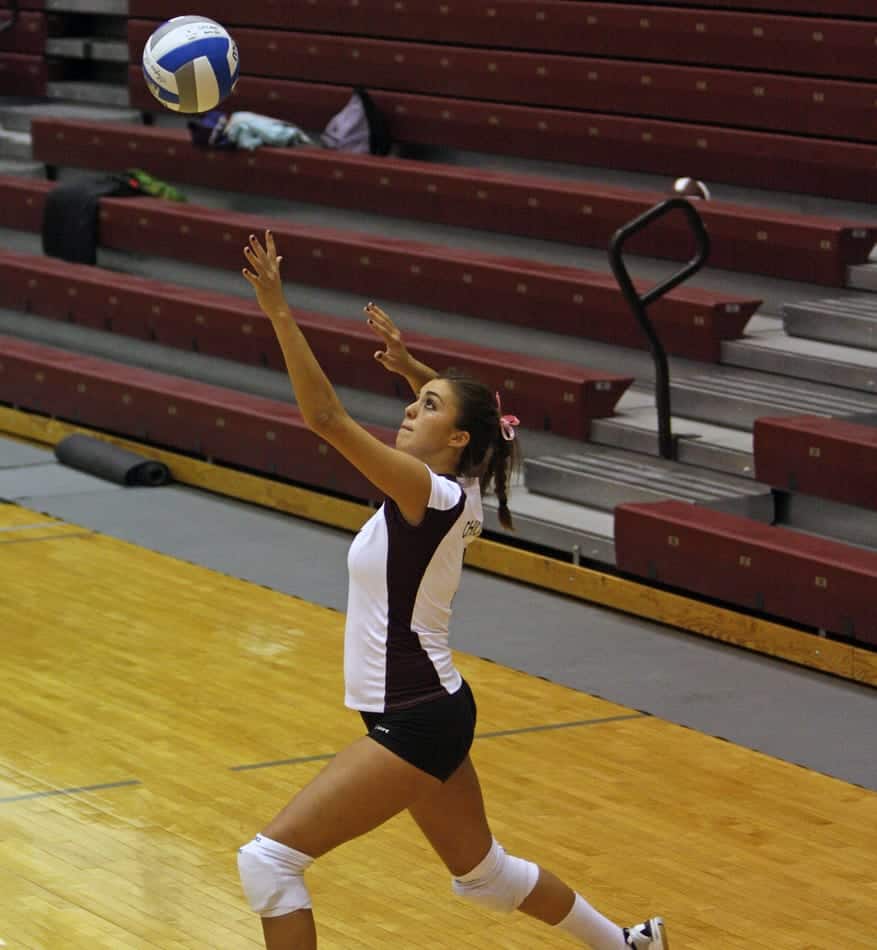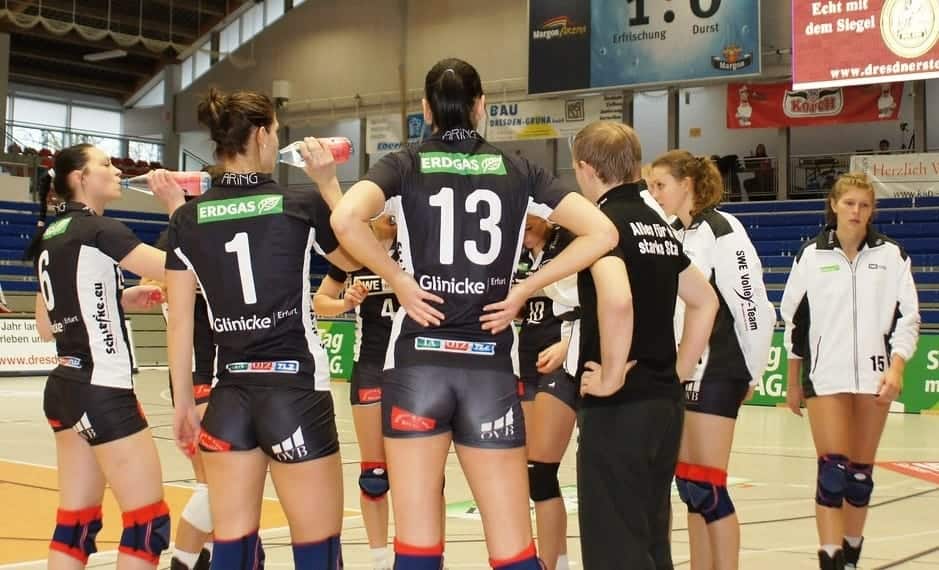Libero is a very unique position in volleyball. For those unfamiliar with the rules of volleyball or those of us who’ve been around since before the major rule changes in the late
Can the libero serve in volleyball? Yes and No. No, the international rules for the libero do not allow them to serve. Yes, the libero can serve in one rotation position in college, high school, middle school, and club levels all throughout the USA. After serving in that position, they can only serve in that same position for the rest of the game.
Back in 1998, the libero was first introduced into the international indoor volleyball community. In 2002, the NCAA added the libero and most U.S. high schools added the position over the next 3 years.

Rules in volleyball are governed by the local organizations, so you may have some specific rules (whether they have to do with liberos or not) that are unique to your region of the country or even to specific tournaments.
Initially, the libero was not allowed to serve at any level of play. Then in 2004, the NCAA changed the rule to allow the libero to serve in one specific rotation position.
The lower levels followed suit. Now all USAV and NCAA and lower levels of play have all modified the original rules to allow liberos to serve.
If you have more questions about serving rules, visit this post to find the answers: Volleyball Serving Rules: Your Questions Answered
Why The Change To Allow Serving?
The original concept behind the libero position was that they were strictly a defensive position that was created to sustain rallies by improved digging and better passing. They were not to be included in virtually any offense.
While this may sound strange, the idea was to make the game more competitive and more exciting. When you had powerhouse hitting and very few really skilled passers, many points were simply decided by who got a good hit through the blocks.
Over the years the volleyball community has adjusted these initial intentions to allow for some limited involvement in the offense. So the libero can serve, can set (following very specific rules) and hit from a standing position.
The addition of the libero position has also improved volleyball by creating a position that allows for great athletes who are short to still excel without limitations. Before the libero position came along, any short player was a liability for half of the rotation unless they were incredible at jumping.
They would often be forced to be a setter or find another sport once they reached a high level of play. Even as a setter, being short can be challenging and limiting. Although there are many amazing short setters out there, all things being equal, the height would help in blocking and the occasional surprise attack.
Some players who were exceptional at digging and passing with lightning-quick reflexes would still have coaches scratching their heads. How can I use this player, when I am committing to substitute them every single time they get to the front row?
Substitutions in volleyball are limited, and this was a liability that created some problems for coaches. So there’s no telling how many great defensive players were passed over because there wasn’t a role they fit into perfectly.
If you would like to improve your serving, read through our article called: Mastering the 4 Types of Serves in Volleyball
Why Do Liberos Wear A Different Jersey?
So if you’re new to volleyball, following the libero through a game can be dizzying until you get used to understanding that position. To help this, the libero is required to wear a noticeably different jersey than their teammates.

Usually, teams have a “home” jersey and an “away” jersey that are inverse color schemes. The libero will simply wear the opposite jersey from the rest of the team which makes them clearly identifiable to everyone.
Libero Substitutions
The libero is allowed to substitute out for any player on the back row at any point when the play is stopped without any warning or communication with the referee. These substitutions are unlimited.
At any stoppage of play, the libero may substitute with anyone on the back row. When the libero swaps back out, only the player whose spot they took may return to that spot.
Other players will go line up in front of the down ref and wait to be allowed to substitute, but liberos will simply run onto the court and take a back-row position. They have to cross through the “libero replacement zone.”
It is traditional for them to exchange a slap of the hands with whomever they’re switching. The libero replacement zone is the area between the 10-foot line and the end line.
So the libero is allowed to serve for any person they substitute for, but once they serve in that one spot, that’s the only position in the rotation they can serve in for the remainder of the game.
This can be difficult for referees to keep track of, so feel free as you sit in the stands to pay attention. If it seems like the other team’s libero is serving more often, simply keep track of the player whose place they took before serving. If they serve again in someone else’s rotation position, that’s an error and referees should award a point and the ball to the opposing team. The actual rule broken is a rotation error.
We have an in-depth guide to substitutions, check it out here.
In between the substitution for one player and another, the libero must stay off the court for one rally. If you watch carefully, this rule appears to be broken quite often. I used to get frustrated trying to understand why I was seeing this happen over and over.
You will see the libero as they are about to rotate to the front line, suddenly take the server’s position, then the original person they swapped places with will go to the front line and a player coming off the front line will go to the bench. It certainly looks like they broke the rule!
The reason this is allowed is that the rule has this exception: If the libero is rotating into the serving position, they don’t have to come off the court for a rally.
The invention and addition of the libero certainly have changed the dynamics of volleyball forever. It has allowed a more diverse assortment of players to excel at the sport.

It allows coaches more options for strategy and creates all kinds of problems for the offense to solve. Although it may seem odd the first time you discover it, embrace the libero concept, it’s been good for the sport.
To continue learning about liberos, take a moment to read our Master Guide To Liberos.
Related Questions
Can a Libero Spike?
The libero can only hit or attack the ball from a standing position. The actual rule is that the attack cannot take place above the height of the net.
Referees will usually call any airborne attack by a libero as a violation. Since it’s not realistic for the referee to get down on the level of the net in time to witness if the ball was at a higher level than the plane of the net, it’s simply understood that a jumping attack will be ruled as “above the net”.
Can a Libero Be a Captain?
According to FIVB International rules, liberos can’t be team captain. While this may seem like an arbitrary rule, the captain is responsible for communicating with the officials on behalf of the team and one of the keys times this is the case is at the beginning of the match while they check the lineup. Since the libero can’t be in the starting lineup, they would be on the bench.
Can You Play With 2 Liberos?
Coaches can designate no liberos, 1 libero or 2 liberos at the beginning of the set when they submit their lineup. One strategy in the early years was to have 2 liberos and save on substitutions even more (because liberos have unlimited substitutions).
The problem is they aren’t allowed to be on the court at the same time, so if you have 2 exceptionally strong defensive players, it’s more advantageous to have one as a libero and the other as a defensive specialist. For this reason, you hardly ever see a 2 libero system being used. Whenever you see 2 liberos designated, one will be playing the majority and the other is a backup.
Photo credits:
Feature image Lcrward on flickr.com: https://creativecommons.org/licenses/by-nd/2.0/, cropped for size.
Serving image by Eric Guo on flickr.com: https://creativecommons.org/licenses/by/2.0/
USA Volleyball image by skeeze from Pixabay
Team huddle image by Michael Panse on flickr.com: https://creativecommons.org/licenses/by-nd/2.0/
Recent Posts
Athletes, listen up! Do you have a closet full of old jerseys, sweatpants, and tees that you just can't seem to part with? Well, dust them off, because you're sitting on a goldmine of fashion...
You may have heard, or you may have noticed, that there's been a change to the rule about double contact in volleyball. In 2022, an experimental rule change began to be implemented, where the double...
